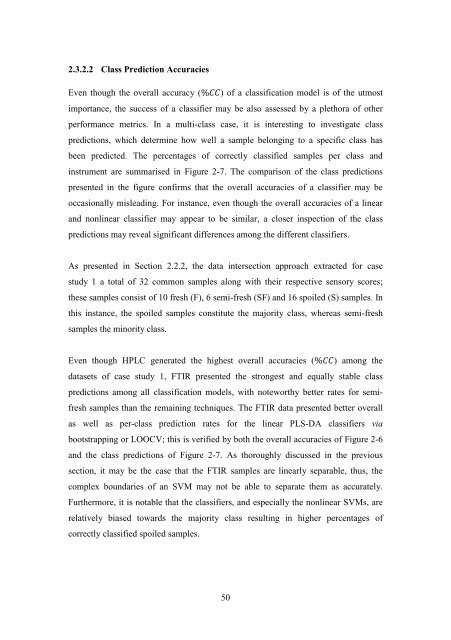CRANFIELD UNIVERSITY Eleni Anthippi Chatzimichali ...
CRANFIELD UNIVERSITY Eleni Anthippi Chatzimichali ...
CRANFIELD UNIVERSITY Eleni Anthippi Chatzimichali ...
Create successful ePaper yourself
Turn your PDF publications into a flip-book with our unique Google optimized e-Paper software.
2.3.2.2 Class Prediction Accuracies<br />
Even though the overall accuracy ( ) of a classification model is of the utmost<br />
importance, the success of a classifier may be also assessed by a plethora of other<br />
performance metrics. In a multi-class case, it is interesting to investigate class<br />
predictions, which determine how well a sample belonging to a specific class has<br />
been predicted. The percentages of correctly classified samples per class and<br />
instrument are summarised in Figure 2-7. The comparison of the class predictions<br />
presented in the figure confirms that the overall accuracies of a classifier may be<br />
occasionally misleading. For instance, even though the overall accuracies of a linear<br />
and nonlinear classifier may appear to be similar, a closer inspection of the class<br />
predictions may reveal significant differences among the different classifiers.<br />
As presented in Section 2.2.2, the data intersection approach extracted for case<br />
study 1 a total of 32 common samples along with their respective sensory scores;<br />
these samples consist of 10 fresh (F), 6 semi-fresh (SF) and 16 spoiled (S) samples. In<br />
this instance, the spoiled samples constitute the majority class, whereas semi-fresh<br />
samples the minority class.<br />
Even though HPLC generated the highest overall accuracies ( ) among the<br />
datasets of case study 1, FTIR presented the strongest and equally stable class<br />
predictions among all classification models, with noteworthy better rates for semifresh<br />
samples than the remaining techniques. The FTIR data presented better overall<br />
as well as per-class prediction rates for the linear PLS-DA classifiers via<br />
bootstrapping or LOOCV; this is verified by both the overall accuracies of Figure 2-6<br />
and the class predictions of Figure 2-7. As thoroughly discussed in the previous<br />
section, it may be the case that the FTIR samples are linearly separable, thus, the<br />
complex boundaries of an SVM may not be able to separate them as accurately.<br />
Furthermore, it is notable that the classifiers, and especially the nonlinear SVMs, are<br />
relatively biased towards the majority class resulting in higher percentages of<br />
correctly classified spoiled samples.<br />
50
















